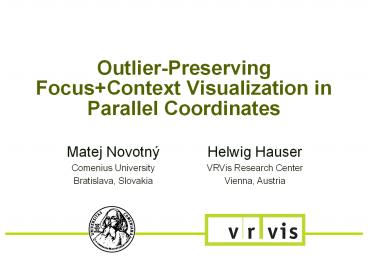Outlier-Preserving Focus Context Visualization in Parallel Coordinates - PowerPoint PPT Presentation
Title:
Outlier-Preserving Focus Context Visualization in Parallel Coordinates
Description:
Data abstraction. Density-based representation of data. Trends are ... Data abstraction based on density rep. Data operations - outlier detection, clustering ... – PowerPoint PPT presentation
Number of Views:36
Avg rating:3.0/5.0
Title: Outlier-Preserving Focus Context Visualization in Parallel Coordinates
1
Outlier-Preserving FocusContext Visualization in
Parallel Coordinates
Matej Novotný Comenius University Bratislava, Slovakia Helwig Hauser VRVis Research Center Vienna, Austria
2
Our goal
- A parallel coordinates visualization that
- Employs FocusContext
- Handles outliers
- Renders effectively
3
Overview
- Motivation
- Abstraction, FocusContext
- Outliers
- Workflow
- Binning
- Context
- Benefits
- Bonus!
- Results and conclusions
4
Parallel Coordinates
- Insight into multidimensional data
- Correlations, Groups, Outliers
5
Parallel Coordinates
- Insight into multidimensional data
- Correlations, Groups, Outliers
6
Parallel Coordinates
- Insight into multidimensional data
- Correlations, Groups, Outliers
7
Large data visualization
- Large data cause clutter in visualization
- 16.000 records
8
Large data visualization
- Transparency used to decrease clutter
- 16.000 records
9
Large data visualization
- Transparency used to decrease clutter ?
- 32.000 records
10
Large data visualization
- Transparency used to decrease clutter ??
- 64.000 records
11
Large data visualization
- Transparency used to decrease clutter ???
- 100.000 records
12
Large data visualization
- Transparency used to decrease clutter ???
- Do these records belong to the main trend?
13
Data abstraction
- Density-based representation of data
- Trends are clearly visible
16 bins
14
Related work
- Hierarchical Parallel Coordinates(Fua et al.,
1999) - Visual representationof clusters
- Smooth transparency
- Cluster centersemphasized
15
Related work
- Revealing Structure within Clustered Parallel
Coordinates Displays (Johansson et al., 2005) - Textures, density
- Transfer functions
- Clusters
- Outliers
16
Outliers
- Different, sparse, rare
- Why should we care?
- Investigation (special cases in simulations)
- Security (network intrusion, suspicious
activity) - Detect errors in data acquisition
- Outliers can be considered in
- Data space
- Screen space
17
Outliers
Outliers are like kids. If you leave them
unattendedthey either get lostor they break
stuff.
18
Outliers
- Avoid losing them in visualization
- e.g. due to transparency or abstraction
- Improve data abstraction or FC
- e.g. remove outliers from clustering
19
Workflow
20
Workflow
21
Step 1 Binning
- 2D binning
- Density-based rep.
- Screen-oriented
- Low memory demandscompared to nD
- Every segmentseparately
- Result bin map
22
Benefits of binning?
- Operations no longer dependon the size of the
input - Information is preserved
- Variable precision of binning
- Variable precision of visual output
- Fine binning does not destroy details
- Larger bins can be producedfrom finer bins
128x128 bins
23
Step 2 Outlier detection
- Various criteria can be employed
- e.g. isolated bins, median filter
64x64 bin map
32x32 bin mapmedian filter
32x32 bin mapisolated bins
24
Step 3 Generating Context
- Outliers ? opaque lines
- Binned trends ? quads
- Population mapped to color intensity
- No blending
- Low visual complexity
- Rendering order according to population
8 bins
25
Step 4 Add Focus
8 bins
26
Benefits
- Operations performed on bin maps
- Reduced complexity
- Results coherent with visual output
- More operations feasible e.g. Clustering
- Outliers handled separately
- Increased information value
- Clearer context
- Output-sensitive implementation
- View divided into layers and segments
27
Results
- Large data can be rendered and explored
- 3 millions records, 16 dimensions, 32 bins
- Binned in 30 sec, rendered instantly (3Ghz,64bit)
28
- BONUS!
- Clustering
29
Clustering, step 0
- Apply Gaussian to smooth out the bin map
- Segmentation data, Green vs Darkness
30
Clustering, further steps
- Start with the highest population
- Decrease the population threshold
- Old clusters grow
- New clusters emerge
50
20
10
0
31
Clustering results
R B G D S H
32
Clustering results
R B G D S H
33
Clustering results
R B G D S H
34
Clustering results
R B G D S H
35
Conclusions
- Data abstraction based on density rep.
- Data operations - outlier detection, clustering
- FocusContext
- Variable context precision
- Outliers preserved
- Much clearer view for large data
- Screen-oriented and output-sensitive
- Interactive visualization of large data
36
Acknowledgements
- K-Plus
- Vega grant 1/3083/06.
- AVL List GmbH - data
- Juergen Platzer
- Prof. Peter Filzmoser
- Harald Piringer
- Michael Wohlfahrt
37
Thank you for your attention!































